On-Coupling Mechanical, Electrical and Thermal Behavior of Submarine Power Phases
Abstract
:1. Introduction
2. Multiphysical Power Phase Models
2.1. Cable Design and Characteristics
2.2. Mechanical Model
2.3. Electrical Model of the Conductor
2.4. Thermoelectric Model of the Phase
3. Results and Discussion
3.1. Results of the Mechanical Model
3.2. Results of the Electrical Model
3.3. Results of the Thermoelectric Model
3.4. Plasticity Effect on the Thermal Behavior of the Phase
3.5. Effect of Strand Failure on the Thermal Behavior of the Phase
4. Conclusions
Author Contributions
Funding
Conflicts of Interest
References
- Matine, A.; Bonnard, C.H.; Blavette, A.; Bourguet, S.; Rongere, F.; Kovaltchouk, T.; Schaeffer, E. Optimal Sizing of Submarine Cables from an Electro-Thermal Perspective. In Proceedings of the 12th European Wave and Tidal Energy Conference (EWTEC), Cork, Ireland, 27 August 2017. [Google Scholar]
- Cheikh, F.E.; Das, R.J.; Drissi-Habti, M.; Ravot, N.; Auzanneau, F. Numerical simulation of high-voltage composite cable for offshore wind. In Proceedings of the 17th European Conference on Composite Materials, ECCM 2016, Munich, Germany, 26–30 June 2016. [Google Scholar]
- Cheikh, F.E. Modélisations Numérique et Analytique du Comportement Mécanique et Multi-Physique d’une Phase de Câble de Haute-Tension Pour Fermes Offshores. Ph.D. Thesis, Ecole Centrale de Nantes, Nantes, France, 2018. [Google Scholar]
- Worzyk, T. Submarine Power Cables: Design, Installation, Repair, Environmental Aspects; Springer: Berlin/Heidelberg, Germany, 2009; pp. 51–103. [Google Scholar]
- Napieralski, P.; Napieralska-Juszczak, E.; Zeroukhi, Y.A. Nonuniform Distribution of Conductivity Resulting from the Stress Exerted on a Stranded Cable During the Manufacturing Process. IEEE Trans. Ind. Appl. 2016, 52, 3886–3892. [Google Scholar] [CrossRef]
- Liu, D.S.; Chen, D.Y.; Chao, Y.C. A Thermomechanical Study of the Electrical Resistance of Cu Lead Interconnections. J. Electron. Mater. 2006, 35, 958–965. [Google Scholar] [CrossRef]
- Hruska, F.H. Calculation of stresses in wire rope. Wire Wire Prod. 1951, 26, 766–767. [Google Scholar]
- Costello, G.A. Theory of Wire Rope, 2nd ed.; Springer: New York, NY, USA, 1997. [Google Scholar]
- Papailiou, K.O. On the bending stiffness of transmission line conductors. IEEE Trans. Power Deliv. 1997, 12, 1576–1588. [Google Scholar] [CrossRef]
- Ghoreishi, S.R.; Messager, T.; Cartraud, P.; Davies, P. Validity and limitations of linear analytical models for steel wire strands under axial loading, using a 3D FE model. Int. J. Mech. Sci. 2007, 49, 1251–1261. [Google Scholar] [CrossRef] [Green Version]
- International Electrotechnical Commission. Electric Cables—Calculation of the Current Rating; IEC 60287-1:2006; IEC: Geneva, Switzerland, 2006. [Google Scholar]
- M-Bonnet, A. Analyse des Solides Déformables par la Méthode des Eléments Finis; Ecole Polytechnique: Palaiseau, France, 2007. [Google Scholar]
- Ghoreishi, S. Modelisation Analytique et Caracterisation Experimentale du Comportement de Cables Synthetiques. Master’s Thesis, Ecole Centrale de Nantes, Nantes, France, 2005. [Google Scholar]
- Jang, J.Y.; Chiu, Y.W. Numerical and experimental thermal analysis for a metallic hollow cylinder subjected to step-wise electro-magnetic induction heating. Appl. Therm. Eng. 2007, 27, 1883–1894. [Google Scholar] [CrossRef]
- Long, C. Essential Heat Transfer, 1st ed.; Prentice Hall: Upper Saddle River, NJ, USA, 1999. [Google Scholar]
- Churchill, S.; Chu, H. Correlating equations for laminar and turbulent free convection rom a horizontal cylinder. Int. J. Heat Mass Transf. 1975, 18, 1049–1053. [Google Scholar] [CrossRef]
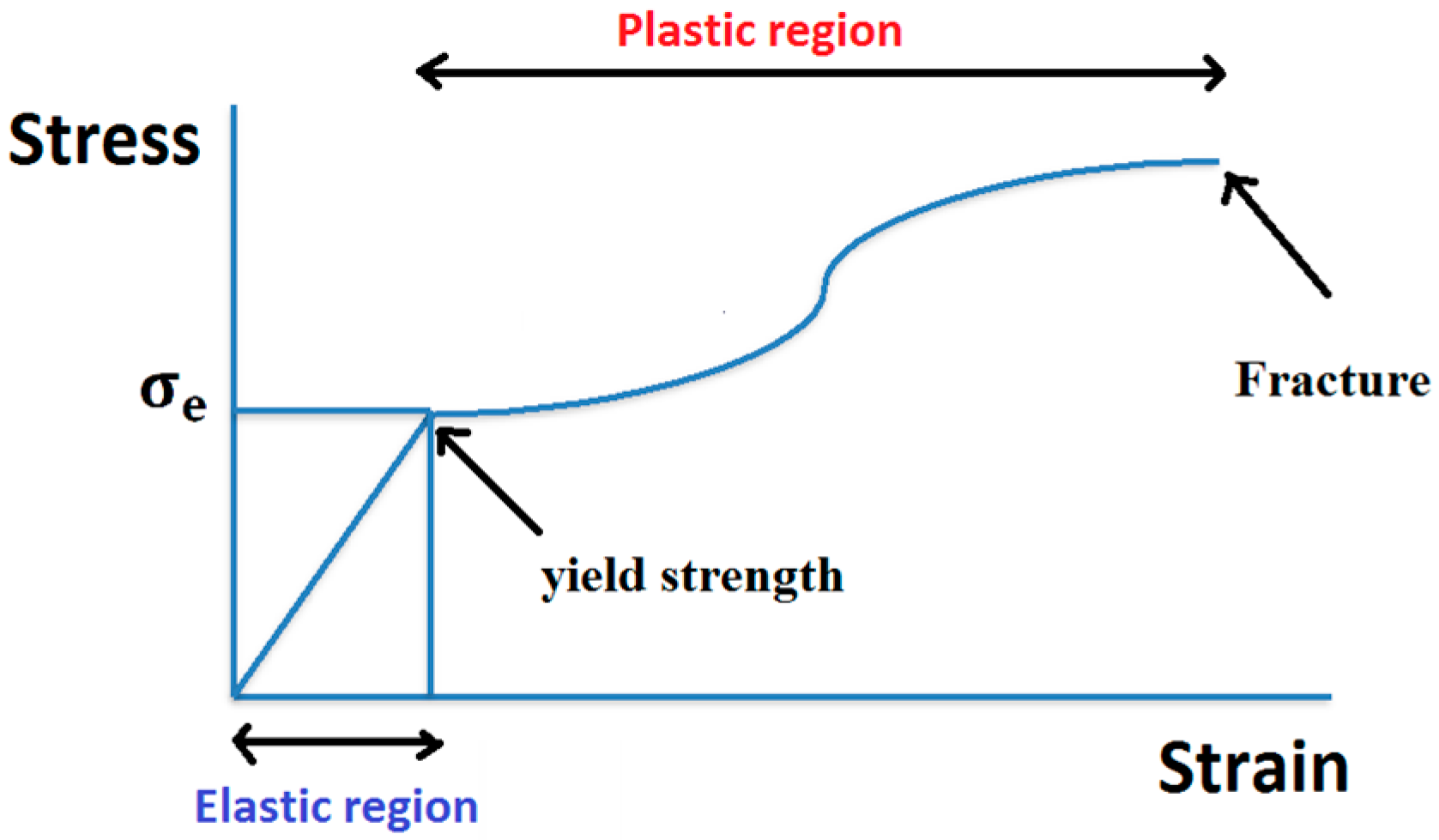
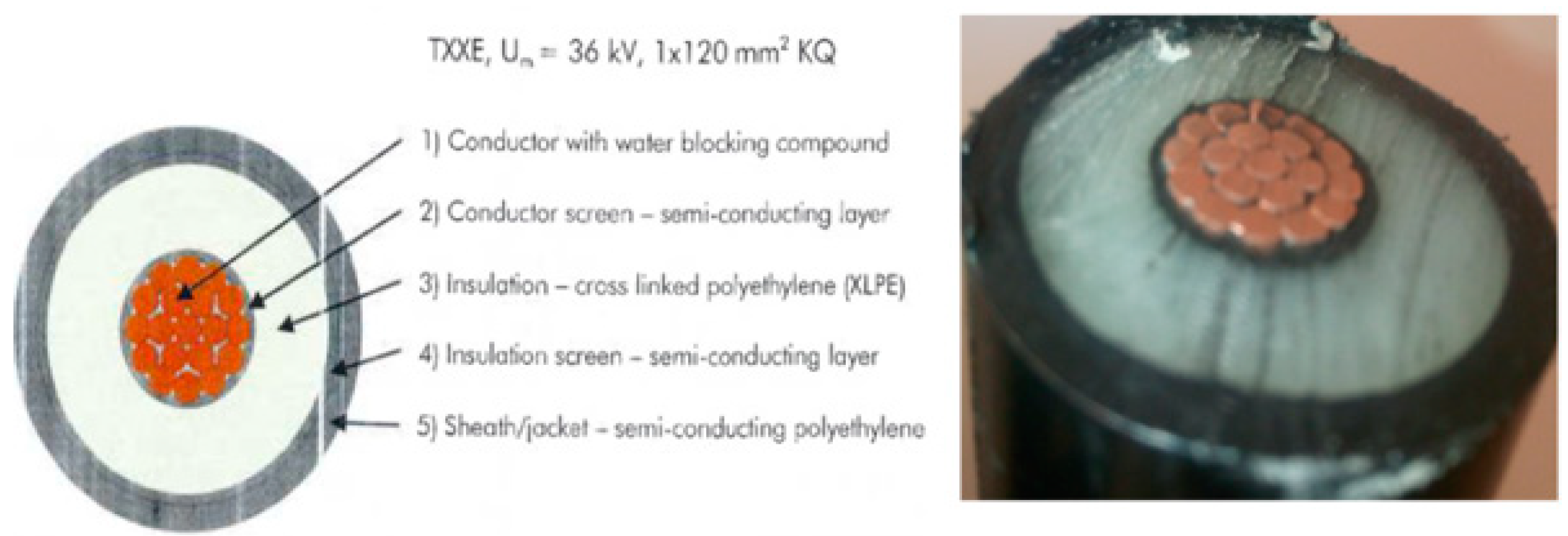
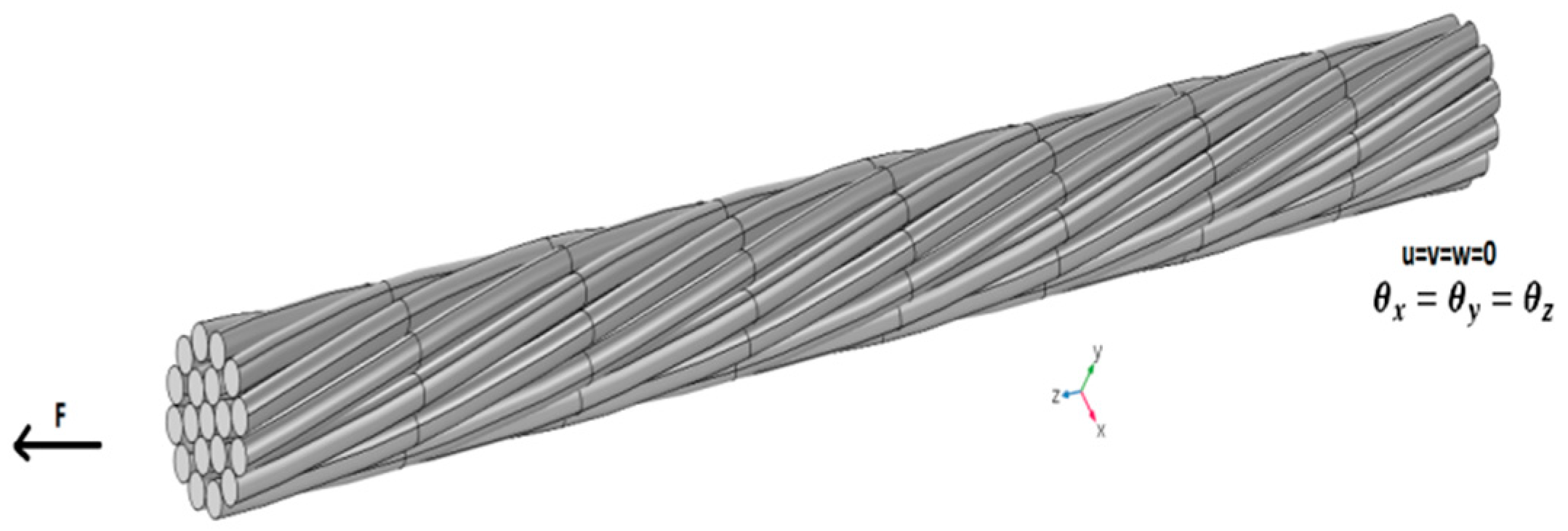
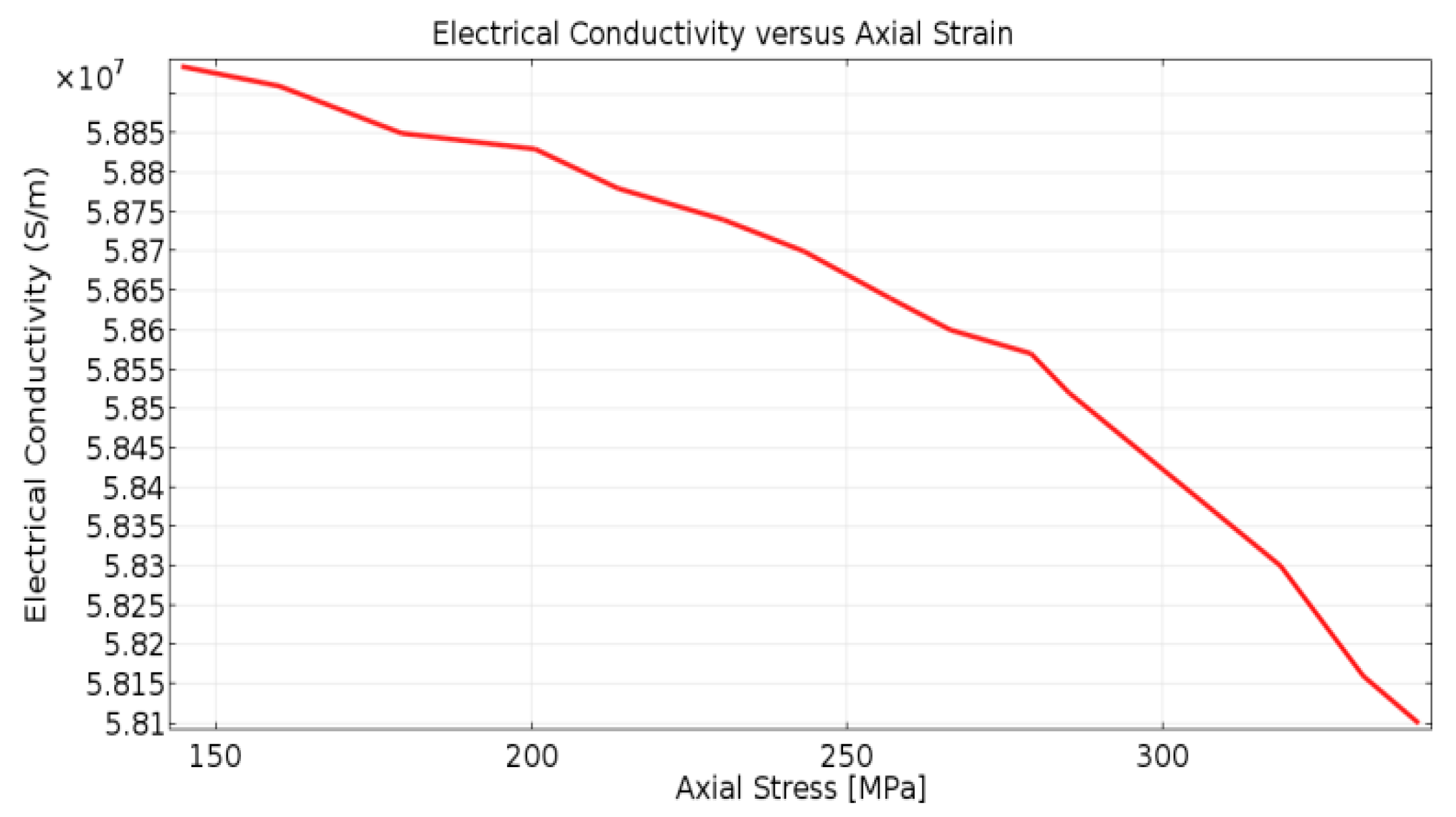

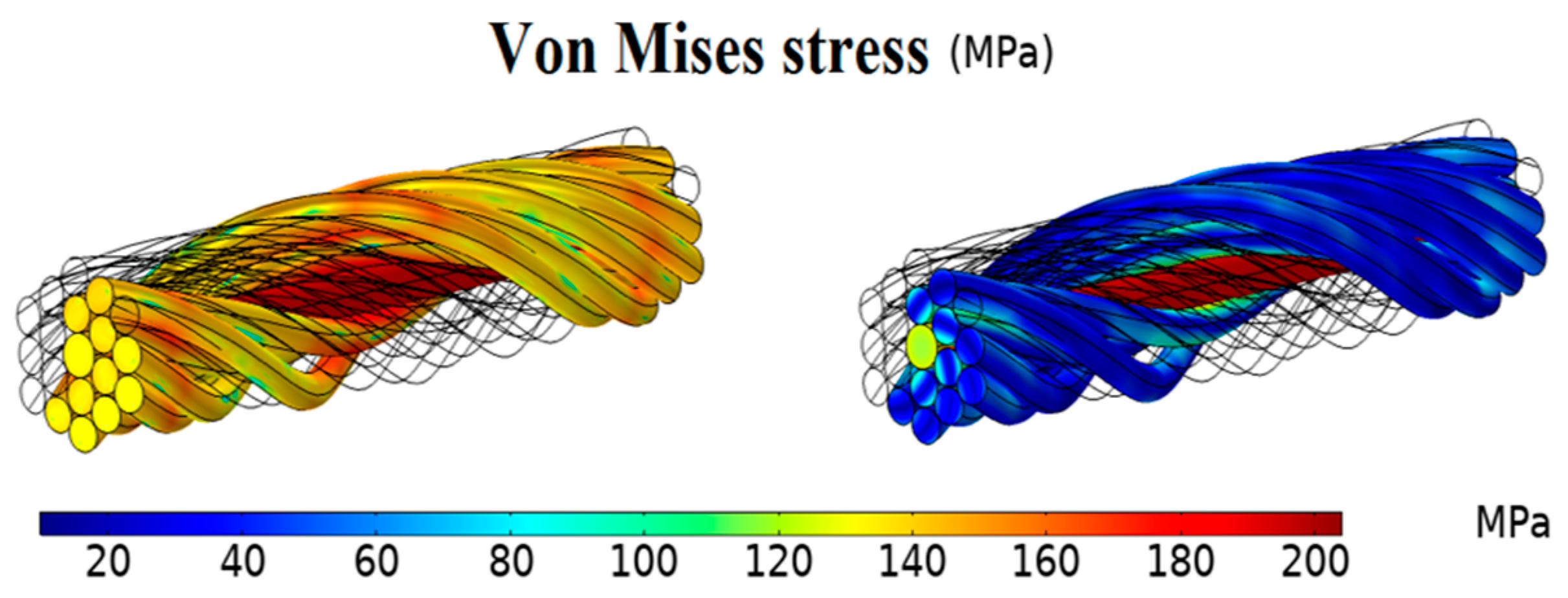
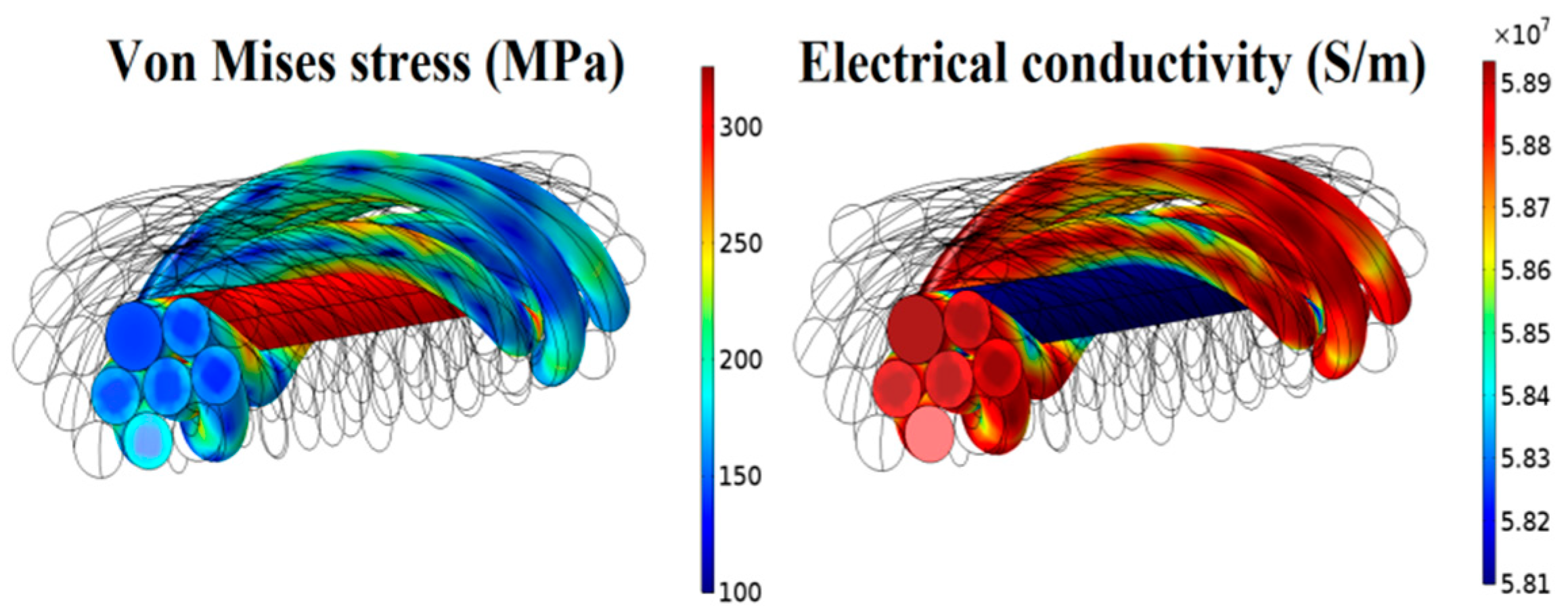
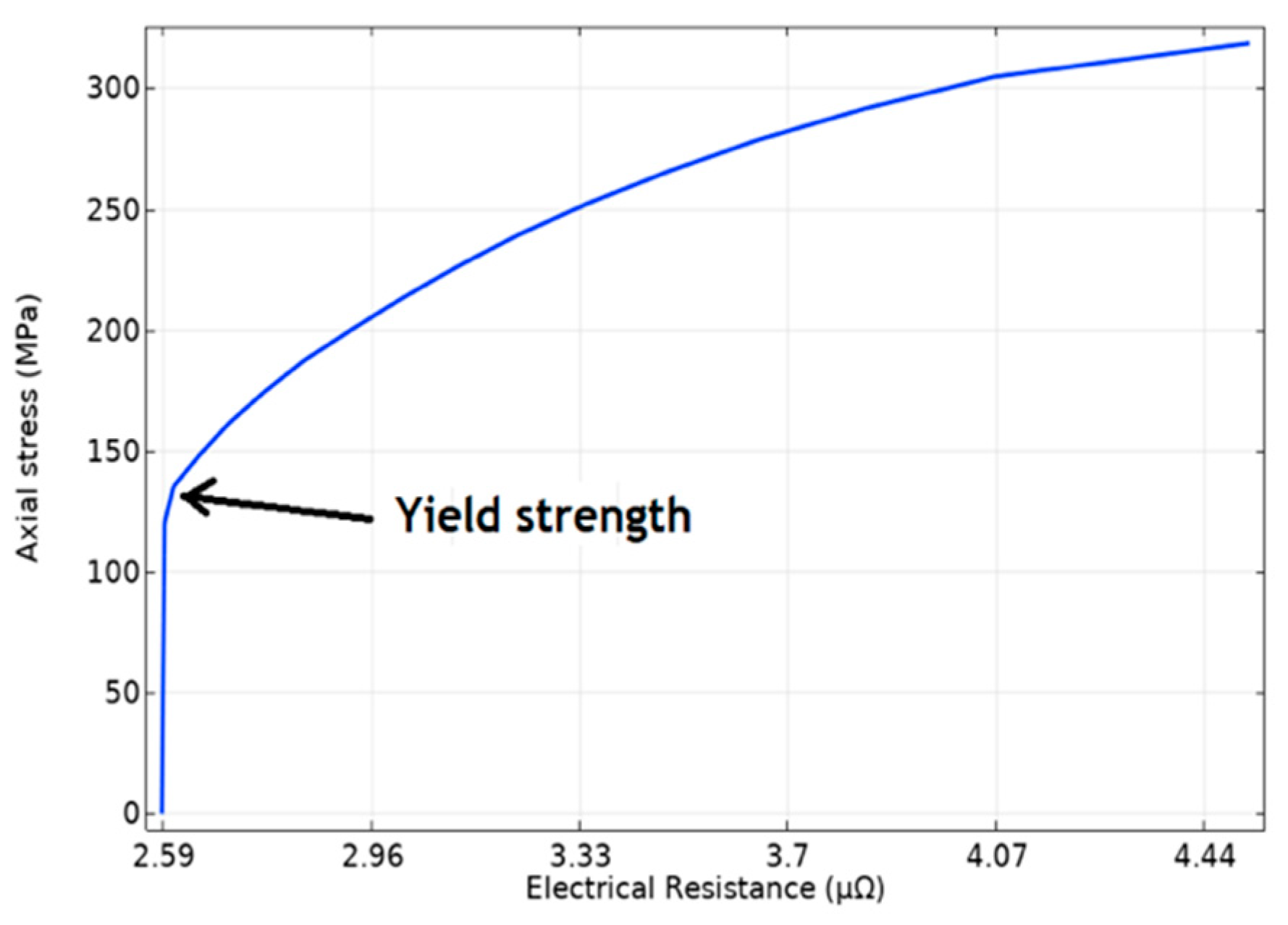
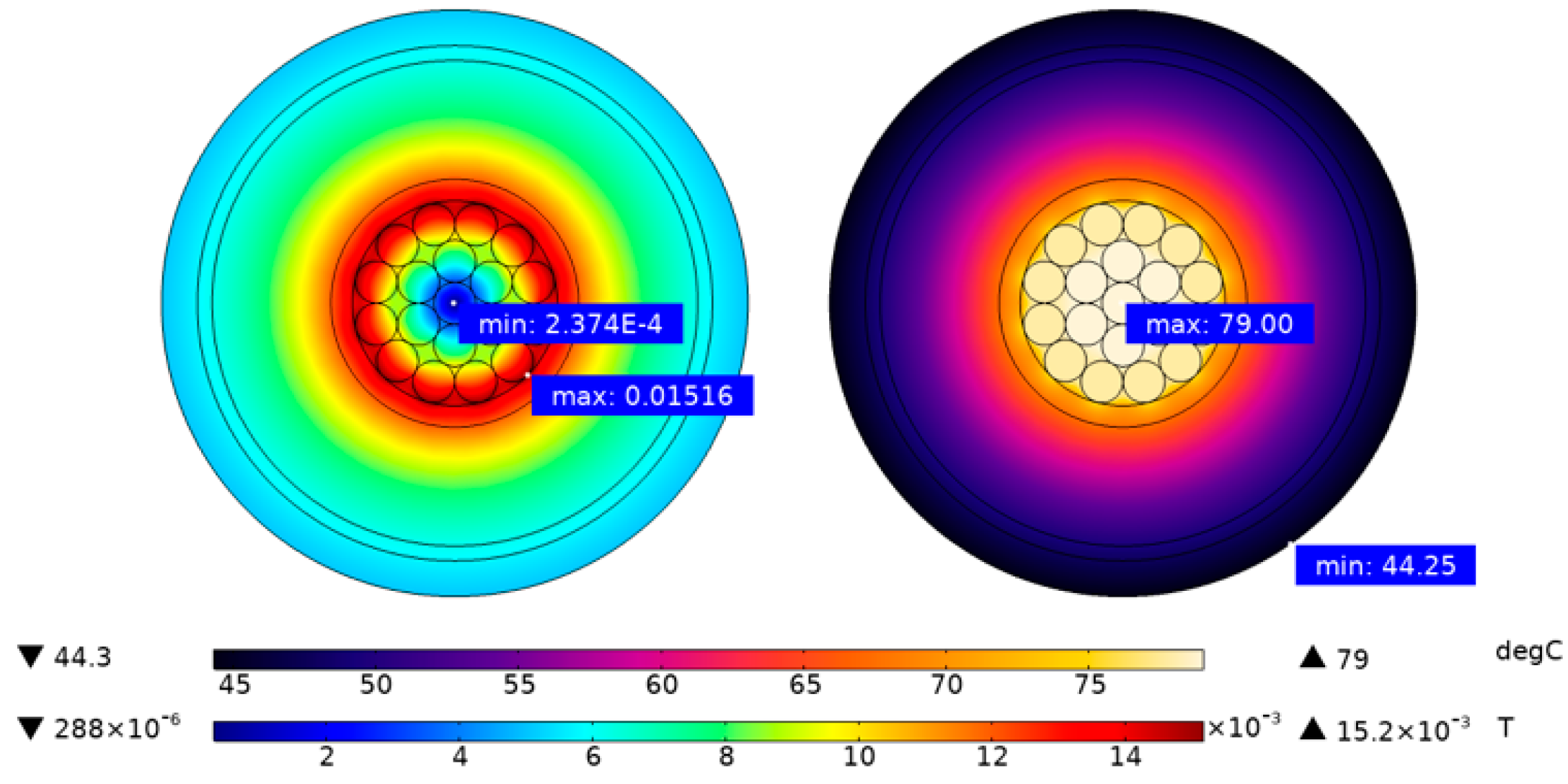
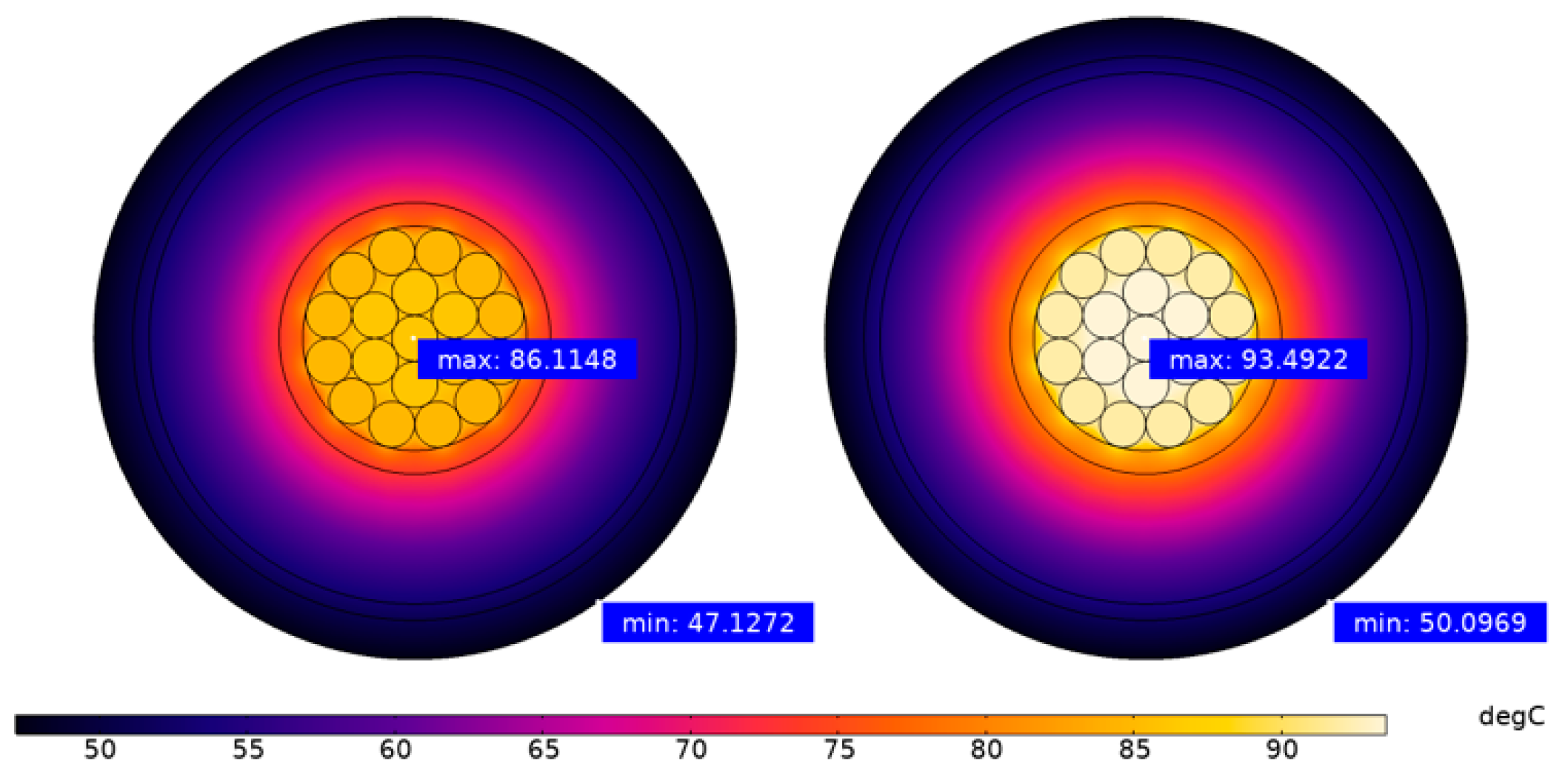
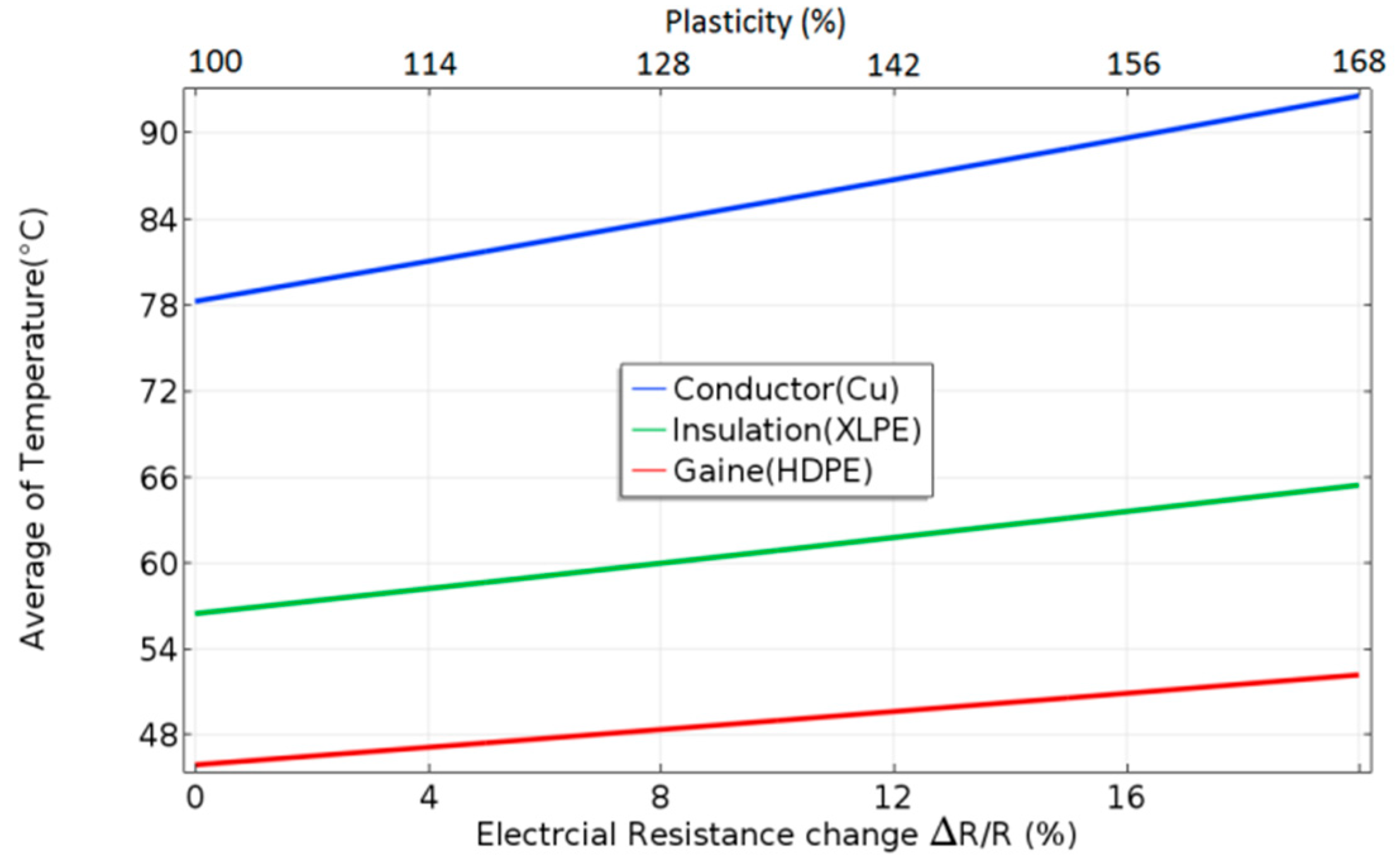
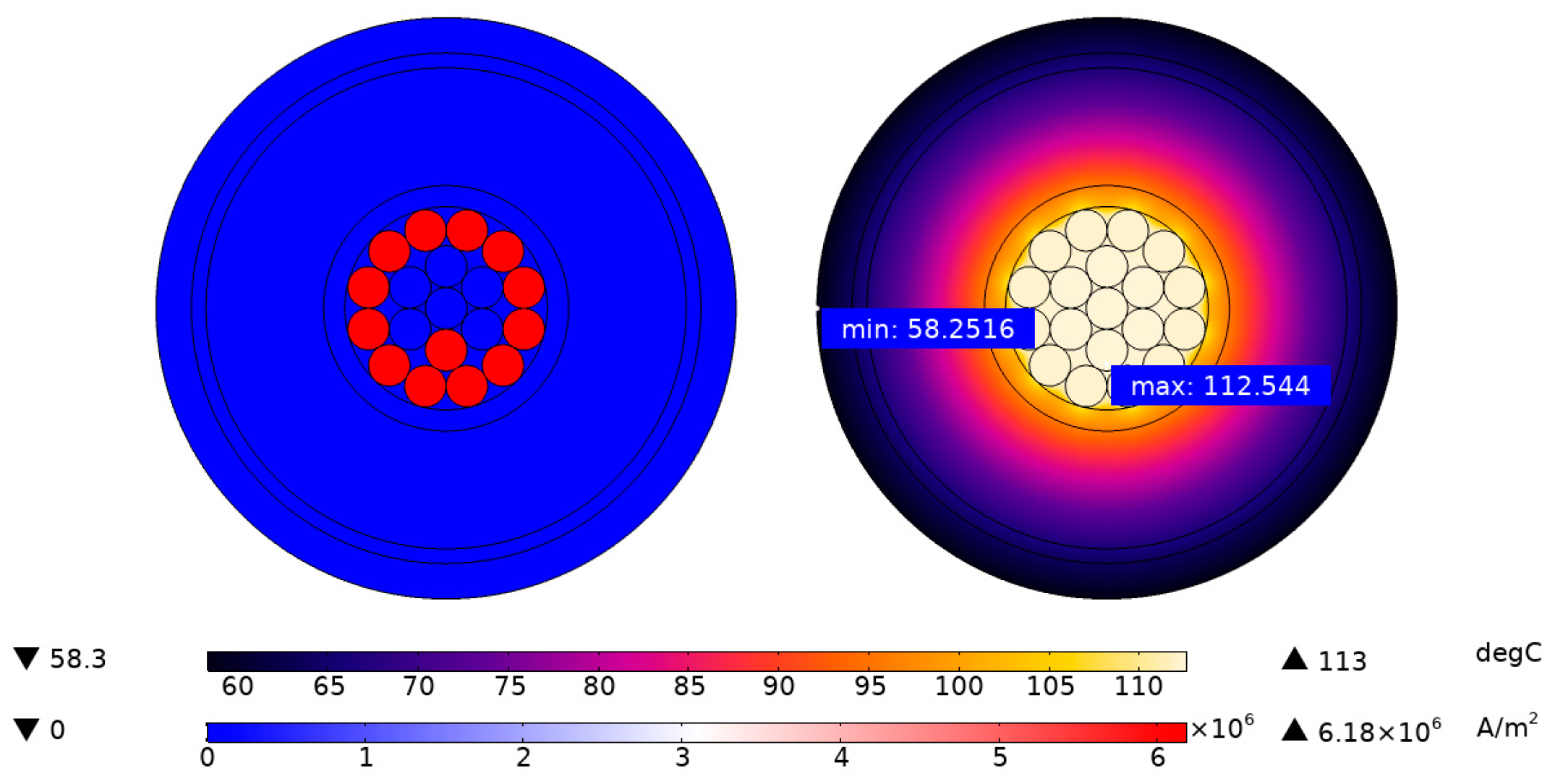
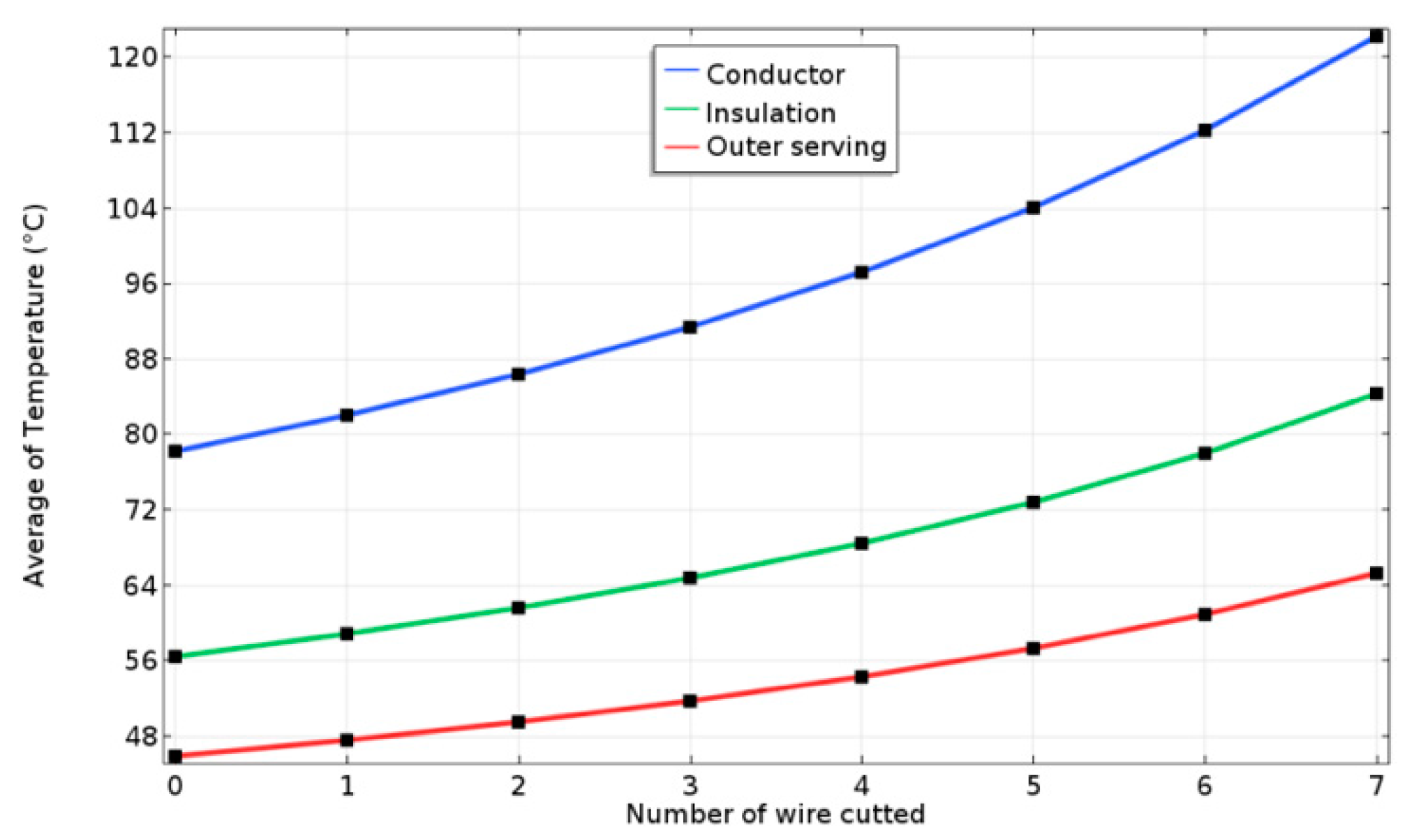
| Component | Material | Thermal Conductivity (W∙K−1∙m−1) | Heath Capacity (MJ∙m−3 K−1) | Young’s Modulus (GPa) | Poisson’s Ratio |
|---|---|---|---|---|---|
| Conductor | Copper (Cu) | 370.40 | 3.45 | 112 | 0.30 |
| Conductor Screen | Semiconducting polymer | 0.50 | 2.40 | 0.34 | 0.34 |
| Insulation | Crosslinked polyethylene (XLPE) | 0.28 | 2.40 | 0.35 | 0.40 |
| Insulation Screen | Semiconducting polymer | 0.50 | 2.40 | 0.34 | 0.34 |
| Sheath | Polyethylene (PE) | 0.20 | 1.70 | 0.34 | 0.40 |
| True Stress (MPa) | Plastic Strain (1) |
|---|---|
| 135 | 0 |
| 144.49 | 0.01 |
| 159.94 | 0.019 |
| 179.43 | 0.036 |
| 200.38 | 0.06 |
| 213.5 | 0.07 |
| 230.5 | 0.01 |
| 243.36 | 0.11 |
| 256.98 | 0.13 |
| 266.41 | 0.15 |
| 279.25 | 0.16 |
| 285.01 | 0.18 |
| 306.45 | 0.21 |
| 316.75 | 0.24 |
| 328.69 | 0.28 |
| 340.76 | 0.29 |
© 2019 by the authors. Licensee MDPI, Basel, Switzerland. This article is an open access article distributed under the terms and conditions of the Creative Commons Attribution (CC BY) license (http://creativecommons.org/licenses/by/4.0/).
Share and Cite
MATINE, A.; DRISSI-HABTI, M. On-Coupling Mechanical, Electrical and Thermal Behavior of Submarine Power Phases. Energies 2019, 12, 1009. https://doi.org/10.3390/en12061009
MATINE A, DRISSI-HABTI M. On-Coupling Mechanical, Electrical and Thermal Behavior of Submarine Power Phases. Energies. 2019; 12(6):1009. https://doi.org/10.3390/en12061009
Chicago/Turabian StyleMATINE, Abdelghani, and Monssef DRISSI-HABTI. 2019. "On-Coupling Mechanical, Electrical and Thermal Behavior of Submarine Power Phases" Energies 12, no. 6: 1009. https://doi.org/10.3390/en12061009
APA StyleMATINE, A., & DRISSI-HABTI, M. (2019). On-Coupling Mechanical, Electrical and Thermal Behavior of Submarine Power Phases. Energies, 12(6), 1009. https://doi.org/10.3390/en12061009






